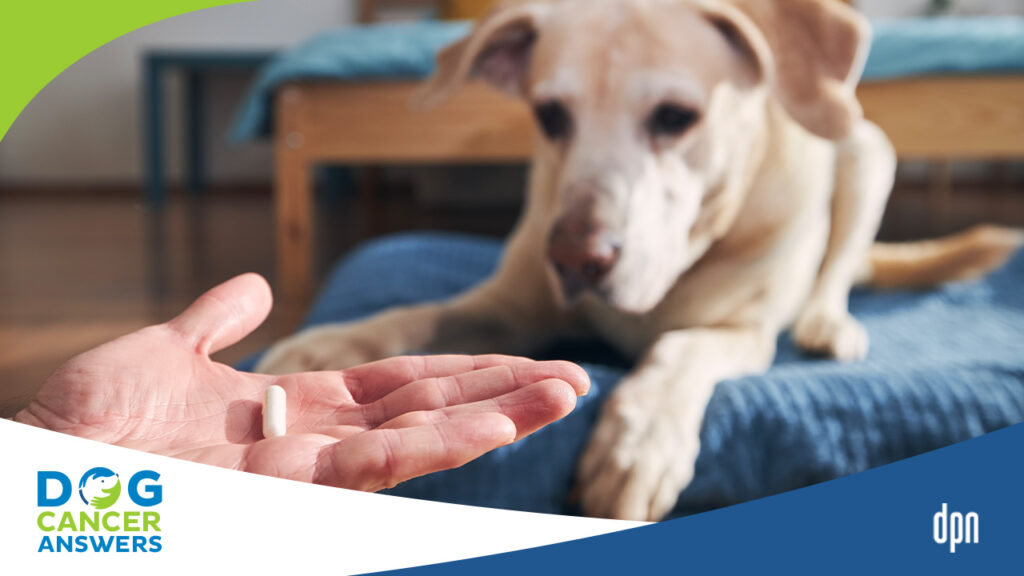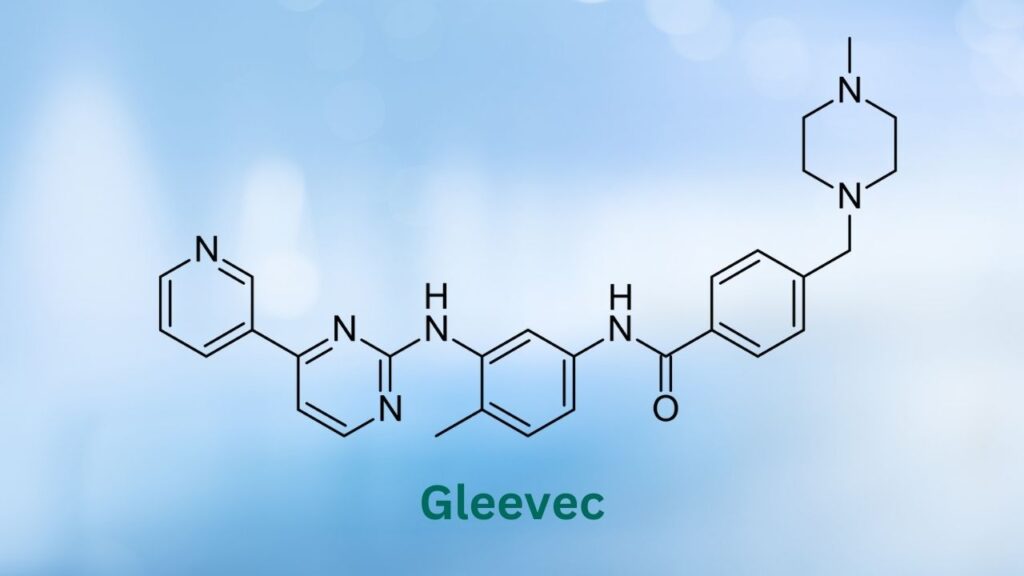Galliprant (generic name: grapiprant) is a non-steroidal anti-inflammatory drug (NSAID) with an excellent safety profile. There is evidence there may be also be some anti-cancer benefits for dogs.
Key Takeaways
- Galliprant is a non-steroidal anti-inflammatory drug (NSAID) that reduces pain and inflammation associated with osteoarthritis.
- Galliprant tends to have fewer and less severe side effects than other NSAIDs.
- Galliprant can be given safely for a long period.
- Galliprant works best when given once a day on an empty stomach.
- Galliprant starts to work 1-2 hours after administration.
- The most common side effects of Galliprant are vomiting, diarrhea, and reduced appetite.
- Galliprant does not appear to cause significant injury to the liver, kidneys, or stomach, but your veterinarian will still want to monitor labwork while your dog is on this medication.
What Is Galliprant?
Grapiprant (brand name Galliprant®) is a non-steroidal anti-inflammatory drug (NSAID) with an excellent safety profile. Intended for use in osteoarthritis, there is evidence that there may also be anti-cancer benefits associated with Galliprant for dogs, although it has not been formally studied yet.4 (More on that below.)
Grapiprant is part of the new pripant class of non-steroidal anti-inflammatory drugs (NSAIDs) approved for use in dogs with osteoarthritis.1,5
This class of NSAIDs is more specific in its targets and has fewer side effects than other NSAIDs for dogs. Galliprant is available in tablet form.1,5
Brand Names
Grapiprant was approved by the FDA’s Center for Veterinary Medicine in March 2016 as a non-cyclooxygenase inhibiting NSAID for veterinary use under the name Galliprant by Elanco.5
How It Works
Grapiprant works a bit differently from other NSAIDs used frequently in dogs. Let’s look at how most NSAIDs work and then at how Grapiprant or Galliprant works.
How Most Non-Steroidal Anti-inflammatory Drugs (NSAIDs) Work
Most non-steroidal anti-inflammatory drugs (NSAIDs) work by inhibiting the function of the cyclooxygenase enzymes (COX-1 and COX-2). Common NSAIDs that inhibit COX enzymes for dogs include:
- carprofen (Rimadyl®)
- deracoxib (Deramaxx®)
- meloxicam (Metacam®)
The COX enzymes trigger prostaglandins, hormone-like substances in the body. Prostaglandins are needed for normal physiologic functions, including pro-inflammatory processes.
When COX-inhibiting NSAIDs stop or reduce COX enzymes, they lower the amount of pro-inflammatory prostaglandins, which reduces inflammation. That’s the effect veterinarians hope for: lower inflammation means lower pain levels.
Unfortunately, these medications also block other prostaglandins involved in other important bodily functions. This means normal functions can be impacted, including serious side effects like stomach ulceration and injury to the liver and kidneys.2,6,7
This is why veterinarians will want to perform routine bloodwork regularly while your dog is on these medications, especially if they need ongoing anti-inflammatory support. This helps them monitor the health of these essential organs, spot problems before they become critical, and adjust doses or medications as needed.
How Grapiprant Works
The pripant class of non-steroidal anti-inflammatory drugs (NSAIDs), of which grapiprant is a member, works a little differently from COX-inhibiting NSAIDs discussed above. It has a much more specific, smaller target than the COX-1 and COX-2 enzymes.
Grapiprant directly targets a prostaglandin that is a major mediator of inflammation: prostaglandin E2 (PGE2).
Even more specifically, grapiprant targets only one receptor of the four PGE2 uses, specifically the fourth receptor, EP4.
To summarize, grapiprant targets a PGE2 receptor, not the COX enzymes that make PGE2. Why is this important? Because the COX enzymes keep doing what they are designed to do: making prostaglandins of all types. Their function isn’t affected at all. Grapiprant only targets one receipt that PGE2, the pro-inflammatory prostaglandin, uses.
COX-1 and COX-2 are not inhibited, which reduces the risk of the serious side effects we see in COX-inhibiting medications. This is good news for your dog overall.
But if your dog has cancer, there is even more good news.
Galliprant and Cancer
The EP4 receptor helps produce pain and inflammation, but EP4 also has a pro-tumor effect on the immune system in cancer cells. In other words, when the EP4 receptor is used, it can encourage tumors in the body.
Galliprant targets the EP4 receptor, making it unusable for other purposes.
In this way, Galliprant may be a two-for-one medication. Because grapiprant inhibits the pro-inflammatory, pro-tumor EP4 receptor, it may also be able to help dogs with cancer.1,4,8,9
I should point out that this medication is not approved for use in dogs with cancer and has not been studied for its effectiveness or safety in dogs with cancer.5,10 However, like all drugs, once it is approved for use in one circumstance, it can be used by veterinarians for other circumstances as they see fit. (Most drugs are used “off-label” in veterinary medicine because most drugs are approved for human use.)
Galliprant’s Effectiveness in Dogs
Galliprant is approved to treat pain and inflammation in dogs with osteoarthritis and can be used over a long period of time due to its excellent safety profile.1,2
Grapiprant’s safety profile and its targeting of the EP4 receptor have encouraged veterinarians to prescribe it because it may be effective at reducing cancer-associated pain in some dogs. 3
When to Not Use
Galliprant should not be used in dogs under nine months of age or weighing less than eight pounds.
Galliprant should not be given to dogs already taking another NSAID, aspirin, or corticosteroids as there may be toxic adverse effects.5,10
Galliprant is not as helpful as other NSAIDs at controlling acute pain over 24 hours. It is most effective at managing chronic pain.11 Depending upon the situation, your veterinarian may use another, more potent NSAID to get the pain under control and then start Galliprant for maintenance pain relief.
Galliprant for Dogs Dosage
Galliprant is a prescription medication, so your veterinarian will determine whether it might help your dog.
The recommended dose of Galliprant is 2mg/kg of body weight once daily. It is sold in flavored 20, 60, and 100mg tablets.5,10
Galliprant is most effective when given on an empty stomach. It can be given at any time of day, but giving it in the morning will allow your dog to take it on an empty stomach and start their day with pain relief.
If your dog vomits after taking this medication, you can try giving the next dose with a small treat. If vomiting continues, consult your veterinarian to determine the best action.12,13
Dogs usually start feeling better 1-2 hours after taking the medication.14
What If I Miss a Dose?
Give it when you remember. If it is close to the time of the next scheduled dose, you should skip the dose you missed and give the next dose as usual. After that, you should resume the regular dosing schedule.
Avoid doubling up or giving extra doses of this medication.14
Storage and Handling
This medication should be stored in the original prescription container, away from light, and at room temperature below 86°F.10,14
Side Effects of Galliprant
Grapiprant has a wide safety margin, confirmed in large field studies of over 250 dogs with osteoarthritis.1,2
It can be administered safely with other therapies such as vaccinations, antibiotics, and flea, tick, and parasitic worm treatments.2,10,15
Galliprant can be used safely for a long time. In one study, dogs were given 25 times the recommended dose for nine months to assess safety. All the dogs remained healthy at the end of the study, with only mild side effects such as diarrhea and vomiting.2,12
Common and Mild Side Effects
Side effects in dogs receiving Galliprant are generally mild but may include:10,15
- Vomiting
- Mucoid, watery, or bloody diarrhea
- Reduced appetite
- Reductions in serum (blood) albumin and total protein
More Severe Side Effects
According to one study, Galliprant does not cause injury to the liver, kidneys, or stomach, even at high doses.2 That said, it’s still a relatively new drug, and we don’t have as much clinical experience as we would like. Your veterinarian will still want to monitor labwork while your pet takes this medication to be sure that all is well with his or her organ function.
Drug Interactions
Grapiprant might cause changes in the effectiveness of other medications given at the same time. Drugbank Online lists 212 medications that may have interactions with grapiprant.5 As with all medications, discussing all other medications or supplements your dog may be taking with your veterinarian before starting grapiprant is important.
MDR1 Mutation
Galliprant should be used with caution in dogs who are homozygous for the MDR1 mutation. It may cause the medication to be at a blood concentration six times higher than in other dogs.1,16
- Sartini I, Giorgi M. Grapiprant: A snapshot of the current knowledge. J Vet Pharmacol Ther. 2021;44(5):679-688. doi:10.1111/jvp.12983
- Rausch-Derra LC, Huebner M, Rhodes L. Evaluation of the safety of long-term, daily oral administration of grapiprant, a novel drug for treatment of osteoarthritic pain and inflammation, in healthy dogs. Am J Vet Res. 2015;76(10):853-859. doi:10.2460/ajvr.76.10.853
- Kirkby Shaw K, Rausch‐Derra LC, Rhodes L. Grapiprant: an EP 4 prostaglandin receptor antagonist and novel therapy for pain and inflammation. Vet Med Sci. 2016;2(1):3-9. doi:10.1002/vms3.13
- Ching MM, Reader J, Fulton AM. Eicosanoids in Cancer: Prostaglandin E2 Receptor 4 in Cancer Therapeutics and Immunotherapy. Front Pharmacol. 2020;11:819. doi:10.3389/fphar.2020.00819
- Grapiprant: Uses, Interactions, Mechanism of Action | DrugBank Online. Accessed December 9, 2022. https://go.drugbank.com/drugs/DB12836
- Limongelli V, Bonomi M, Marinelli L, et al. Molecular basis of cyclooxygenase enzymes (COXs) selective inhibition. Proc Natl Acad Sci. 2010;107(12):5411-5416. doi:10.1073/pnas.0913377107
- Bergh MS, Budsberg SC. The Coxib NSAIDs: Potential Clinical and Pharmacologic Importance in Veterinary Medicine. J Vet Intern Med. 2005;19(5):633-643. doi:10.1111/j.1939-1676.2005.tb02741.x
- Musser ML, Viall AK, Phillips RL, Hostetter JM, Johannes CM. Analysis of gene expression of prostaglandin EP4 receptor in canine osteosarcoma. Can J Vet Res Rev Can Rech Veterinaire. 2021;85(1):68-71.
- Musser ML, Viall AK, Phillips RL, Hostetter JM, Johannes CM. Gene expression of prostaglandin EP4 receptor in three canine carcinomas. BMC Vet Res. 2020;16(1):213. doi:10.1186/s12917-020-02431-2
- Galliprant Product Insert, Elanco. Accessed December 9, 2022. https://www.elancolabels.com/us/galliprant-with-tear-off
- De Salazar Alcalá AG, Gioda L, Dehman A, Beugnet F. Assessment of the efficacy of firocoxib (Previcox®) and grapiprant (Galliprant®) in an induced model of acute arthritis in dogs. BMC Vet Res. 2019;15(1):309. doi:10.1186/s12917-019-2052-0
- Rausch‐Derra LC, Rhodes L, Freshwater L, Hawks R. Pharmacokinetic comparison of oral tablet and suspension formulations of grapiprant, a novel therapeutic for the pain and inflammation of osteoarthritis in dogs. J Vet Pharmacol Ther. 2016;39(6):566-571. doi:10.1111/jvp.12306
- Łebkowska-Wieruszewska B, Barsotti G, Lisowski A, Gazzano A, Owen H, Giorgi M. Pharmacokinetics and estimated bioavailability of grapiprant, a novel selective prostaglandin E 2 receptor antagonist, after oral administration in fasted and fed dogs. N Z Vet J. 2017;65(1):19-23. doi:10.1080/00480169.2016.1241727
- Grapiprant, Plumb’s Veterinary Medication Guides. Accessed December 9, 2022. https://dogcatdoc.com/wp-content/uploads/2021/05/VMG-Grapiprant-GALLIPRANT.pdf
- Rausch-Derra L, Huebner M, Wofford J, Rhodes L. A Prospective, Randomized, Masked, Placebo-Controlled Multisite Clinical Study of Grapiprant, an EP4 Prostaglandin Receptor Antagonist (PRA), in Dogs with Osteoarthritis. J Vet Intern Med. 2016;30(3):756-763. doi:10.1111/jvim.13948
- Heit MC, Mealey KL, King SB. Tolerance and Pharmacokinetics of GalliprantTM Administered Orally to Collies Homozygous for MDR1-1Δ. J Vet Pharmacol Ther. 2021;44(5):705-713. doi:10.1111/jvp.12984
Galliprant® is a registered trademark of Aratana Therapeutics, Inc., manufactured for Elanco US Inc.
Rimadyl® is a registered trademark of Zoetis Services LLC
Deramaxx® is a registered trademark of Novartis
Metacam® is a registered trademark of Boehringer Ingelheim Vetmedica GmbH
Topics
Did You Find This Helpful? Share It with Your Pack!
Use the buttons to share what you learned on social media, download a PDF, print this out, or email it to your veterinarian.









